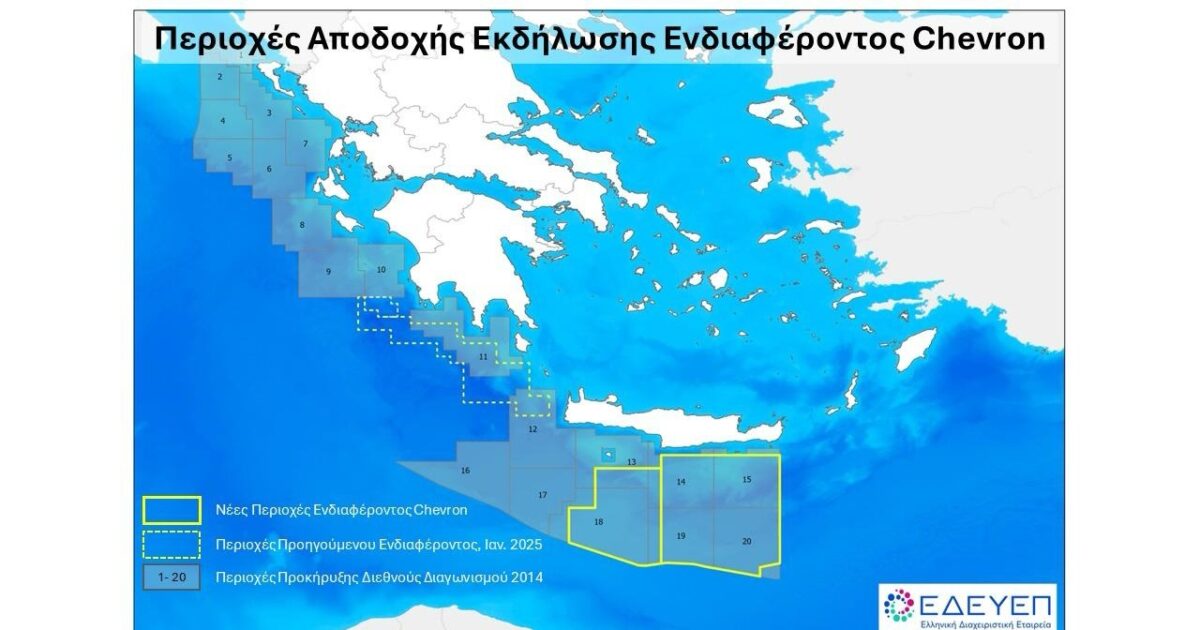The decision of the Ministry of Environment and Energy (RIS) was published in Transparency, announcing the competition for hydrocarbon investigations in the maritime areas south of its Peloponnese (“A2” and “South of the Peloponnese”) and in the maritime areas south of Crete (“South of Crete 1” and “South of Crete 2”).
This decision follows the acceptance of the interest of the company “Chevron Balkans Exploration BV” for a maritime area south of the Peloponnese and for two maritime areas south of Crete, as well as the acceptance of interest from the company “Helleniq Upstream Kyparissiakos “A2” maritime area south of the Peloponnese.
The international competition is expected to be published for 90 days in the official newspaper of the European Union to submit bids by interested companies. The RIS concludes consistently and reliability the timetable for the issuance of ministerial decisions to accept expressions of interest, the definition of expensive coordinates and the declaration of the relevant tender.
As set out in the decision, public income revenue is 20%, with a 5% additional on regional tax. In more detail, according to the decision, the basic terms of the lease contract are as follows:
- According to Presidential Decree 127/1996, the lessee will pay the rental rent for all hydrocarbons and by -products produced and preserved in the conventional area.
- The rent is linked to R/C ratio, where r is cumulative gross revenue and C cumulative expenses. The rent will be linked to the ratio of R/C (coefficient R) based on a variable scale of specific ratios of revenue and expense ratio and will range from a lower limit of 4% on the amount of hydrocarbons produced, in money or in kind, if the coefficient R is less than 0.5. The rent is deducted for the purpose of calculating income tax. Details of calculating the Rate R is included in the lease model.
- The lessee is subject to a special income tax at a rate of twenty percent (20%), as well as a regional tax at a rate of five percent (5%), with no additional regular or extraordinary contribution, a fee or other burden of any nature in favor of the State or any third party.
- For the purposes of determining the annual taxable income, capital costs (for research and growth) are depreciated at 40% to 70% of the value of gross annual production. Capital expenditure that is not recovered any financial year of the lease may be transferred to the following financial years.
- The lessee is charged with all the risks of research and expenditure at the investigation stage. The research stage will last up to 7 years and may be extended in accordance with the hydrocarbon law.
- The Stage of Research is divided into 3 phases. Each phase is related to a separate work program, with the possibility of either moving to the next phase, provided that all contractual obligations have been fulfilled, or resignation at the end of each phase.
- During the transition from one phase to the next investigation stage, the lessee is obliged to release between 20% and 50% of the original conventional area. At the end of the last phase, the entire research area will be released. The areas released will respond to the 5’X 5 ′ elemental rectangular system.
- The crop (per thousand square meters) compensation per year, is kept constant 9 for each investigation phase and is included in competitive data.
- The declaration of commercially exploitable hydrocarbons begins the exploitation stage. The exploitation stage lasts 25 years with the possibility of extending for two periods of 5 years each, subject to renegotiation of the terms of the contract.
- Leasing contracts are governed by Greek law.
- Any dispute arises in relation to the lease contract will be resolved by an expert and/or arbitration.
